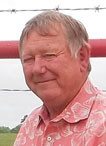
A once nearly extinct American icon can once again be found grazing on the prairies of Delaware County, Okla., thanks to the effort of Cherokee Nation and the InterTribal Bison Cooperative.
Efforts to reestablish bison by the Cherokee people began with the delivery of bulls and females to the Cherokee Nation. It was the first time the Cherokee had attempted to breed the animals in nearly half a century. Today, young calves can be seen roaming with their mothers, and hopes are the herd will continue to flourish for years to come.
Approximately 60 million bison populated North America when Europeans began settlement. Settlers brought change to the bison’s natural habitat, introduced disease through their cattle and increased competition for grazing land.
Bison disappeared west of the Rocky Mountains by 1940. Railroads divided bison into southern and northern herds by the 1860s, many being slaughtered to feed railroad crews, Army posts and to eliminate Native American’s main source of food.
Ranchers began to capture bison in an attempt to domesticate them. Bison hides were processed into leather; bones were used in refining sugar, fertilizer and in bone china. Bison bones sold between 1868 and 1881 represented an estimated 31 million bison.
By 1884, only 325 wild bison were left in the United States, including 25 in Yellowstone National Park.
William Hornaday, director of the New York Zoological Society, estimated the total bison population in 1889 to be just over 1,000 animals, including free ranging herds, the federal herd in Yellowstone, herds in Canada, in zoos and private herds. The American Bison Society (ABS), founded by Hornaday and supported by President Theodore Roosevelt and Canadian Governor Earl Grey, was established in 1905 to preserve and increase the American Bison and was re-established as the Wildlife Conservation Society (WCS).
Bison herds can be found in all 50 states today. Public herds are managed in several national and state parks, wildlife management areas and national refuges. Tribal bison herds are managed on more than 1 million acres of tribal lands. Private ranches are using bison for tourism and production with herds across the country. The economic value of bison is estimated at more than $300 million.
The Cherokee people have a deep connection and history with bison as a source of food, tools and clothing and in traditional ceremonies. The Cherokee Nation, headquartered in Tahlequah, Okla., had not raised bison in 40 years. Cherokee Nation worked with the ITBC for two years in an attempt to bring bison back to Cherokee Nation in 2014.
Thirty-eight 2-year-old female bison from Badlands National Park in South Dakota were delivered to Cherokee Nation land in Delaware County, Okla., in 2014.
Ten bulls joined them from Theodore Roosevelt National Park in North Dakota a few days later. The tribe’s Natural Resources department cares for the bison.
“The ITBC is a super good organization as far as projects and support. You can call them today and if we needed a range technician out here tomorrow, we would have one out tomorrow. Anything we have needed from them, they do their best to provide it for us,” Cherokee Nation Bison herdsman Chris Barnhart said. Cherokee Nation worked with the ITBC and other experts to develop a nutrition program for the bison.
“The herd is growing,” Gunter Gulager director of natural resources for Cherokee Nation told OFN. “We had 21 new calves last year and will have that many or more this year. We would like to get up probably around 200 head,” Gunter said. “It is up to the council and the leadership of Cherokee Nation to decide how to use the fullness of our herd.”
The Cherokee Nation has 200 acres fenced off for the bison with room to expand.
“The birth of these spring calves is an excellent sign for the growth of our bison herd. It means the herd has settled into its new home and they are flourishing,” Cherokee Nation Principal Chief Bill John Baker said. “The reintroduction of bison to the Cherokee Nation is significant because it allows our people to reconnect with an important chapter in our history, when bison were essential to our daily lives.”
In May, the bison became the official national mammal of the United States under legislation signed into law by President Barack Obama.
Lawmakers spearheading the effort say the once nearly extinct icon deserves the elevated stature because of its economic and cultural significance in the nation’s history.







